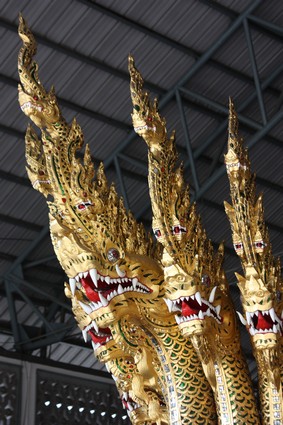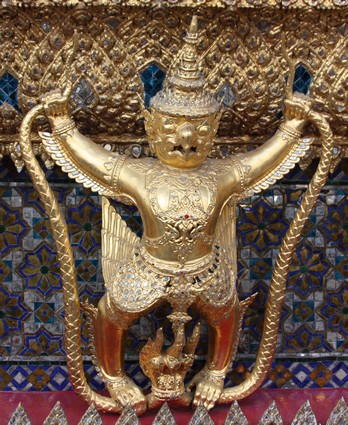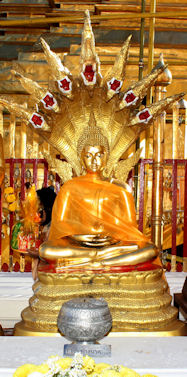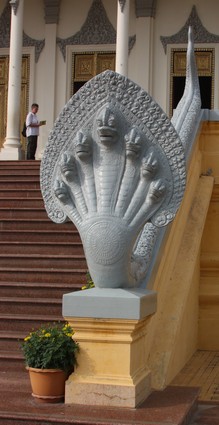Jump Station:
[]
[]
[]
[]
[]
[]
A Simple Guide to Help Understand Hindu Gods
The Naga
- A Snake or a Serpent
"Naga" is the Sanskrit word for a deity taking the form of a very great snake - specifically the King Cobra - or a serpent. This creature is found both in Hinduism and Buddhism. Stories involving the nagas are still very much a part of contemporary cultural traditions in predominantly Hindu regions of Asia (India, Nepal, and the island of Bali). In India, nagas are considered nature spirits and the protectors of springs, wells and rivers. They bring rain, and thus fertility, but are also thought to bring disasters such as floods and drought. According to traditions nagas are only malevolent to humans when they have been mistreated. They are susceptible to mankind's disrespectful actions in relation to the environment. They are also associated with waters-rivers, lakes, seas, and wells-and are generally regarded as guardians of treasure. |
 |
Enmity with Garuda
|
The great nemesis of the Nagas is the gigantic bird-man, Garuda. Garuda and the Nagas began life as cousins.
The sage Kasyapa had two wives, Kadru and Vinata. Kadru desired many offspring. Vinata desired few but powerful offspring. Each got her wish. Kadru laid 1000
eggs which hatched into snakes (nagas). Vinata laid two eggs which hatched into the charioteer of Surya, the sun god, and Garuda. Through a foolish bet, Vinata
became enslaved to her sister, and as a result Vinata's son Garuda was required to do the bidding of the snakes. Although compliant, he chafed and built up a
grudge that he would never forget. The nagas also carry the elixir of life and immortality. When Garuda asked the nagas what he would have to do in order to be released from his bondage, they told him he would have to bring them the elixir of immortality. Garuda stole the elixir from the gods and brought it to the serpents but it was taken away by Indra. However, few drops remained on the grass. The nagas licked up the drops, but in doing so, cut their tongues on the grass, and since then their tongues have been forked. From that point onward, Garuda regarded nagas as enemies and as food. |
 |
The Naga's role in Buddhism
Traditions about nagas are also very common in all the Buddhist countries of Asia. In many countries, the naga concept has been merged with local traditions of great and wise serpents or dragons. In China, the naga was equated with the Chinese dragon.
| The Buddhist naga generally has the form of a great cobra-like snake, usually with a single head but sometimes with many. At least some of the nagas are capable of using magic powers to transform themselves into a human semblance. In Buddhist painting, the naga is sometimes portrayed as a human being with a snake or dragon extending over his head. One naga, in human form, attempted to become a monk; when telling it that such ordination was impossible, the Buddha told it how to ensure that it would be reborn a man, able to become a monk. |  |
In Cambodia
| In a Cambodian legend, the naga were a reptilian race of beings who possessed a large empire or kingdom in the Pacific Ocean region. The Naga King's daughter married an Indian Brahma named Kaundinya, and from their union sprang the Cambodian people. Therefore still Cambodians say that they are "Born from the Naga". The Seven-Headed Naga serpents depicted as statues on Cambodian temples, such as Angkor Wat, apparently represent the seven races within Naga society, which has a mythological, or symbolic, association with "the seven colors of the rainbow". Furthermore, Cambodian Naga possess numerological symbolism in the number of their heads. Odd-headed Naga symbolise the Male Energy, Infinity, Timelessness, and Immortality. This is because, numerologically, all odd numbers come from One. Even-headed Naga are said to be "Female, representing Physicality, Mortality, Temporality, and the Earth." |
 |
(Editor's note, March 19, 2010: This page is now being construction so come back again.
If you have any insights - constructive comments - you wish to share please do so.)
![]()
For more information about our travels write to![]() Belli.
Belli.